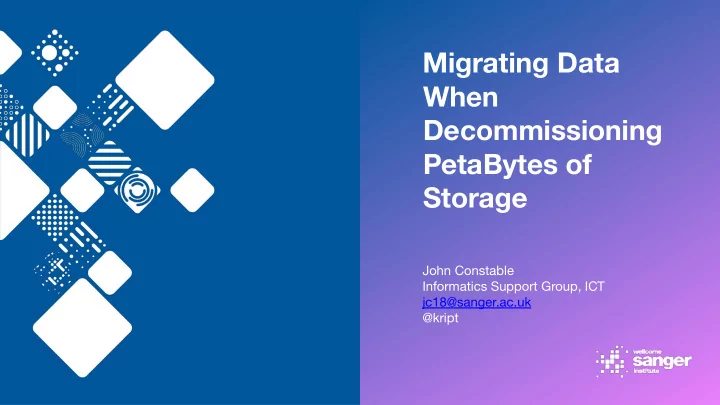

Migrating Data When Decommissioning PetaBytes of Storage John Constable Informatics Support Group, ICT jc18@sanger.ac.uk @kript
Background 19PB of genomic data in 399 Resources ● on 76 resource servers over six Zones 41 servers need decommissioning this ● Imagery Area year, another 10 next year; aka ~10 PB across three types of hardware. Generating 10TB/data week, expecting ● to go up to 760TB if the scientists turn on all the PacBio/Nanopore sequencers they might buy for upcoming programs like 'Tree of Life'
https://docs.irods.org/4.2.6/system_overview/tips_and_tricks/#decom missioning-a-storage-resource Advice is; 1. Determine which iRODS server will host the new device. 2. Create a new iRODS resource that uses the new device. 3. Add the new resource to the appropriate resource hierarchy (could be standalone). 4. Replicate data to the new resource. 5. Trim data from the to-be-retired resource. 6. Remove the to-be-retired resource. 7. Safely disconnect the to-be-retired device.
Imagery and graph area 4. Replicate data to the new resource.
Yak Shaving Any apparently useless activity which, by allowing you to overcome intermediate difficulties, allows you to solve a larger problem. Imagery and graph area "I was doing a bit of yak shaving this morning, and it looks like it might have paid off." Definition credit ghyston.com Photo by Bryan Minear on Unsplash
Standing On The Shoulders Of Giants Imagery and graph area This is mostly the work of my colleague Brett Hartley, with input from Terrell and the iRODS team
Solution One: iphymv within a single subtree “ Physically move a file in iRODS to another storage resource. Note that if the source copy has a checksum value associated with it, a checksum will be computed for the replicated copy and compared with the source value for verification. ” (from the man page)
Solution One: iphymv within a single subtree - REJECTED Issue 4010 - “repl to resource with existing replica does nothing” “Nothing happens. Repl logic short-circuits resource plugins by detecting the good replica and determining that there is nothing to do.”
Solution Two: move resource out of hierarchy and then iphymv. As a bonus, this would also stop new files being written to the resource!
Solution Two: move resource out of hierarchy and then iphymv - REJECTED In 4.1.x the resource location is stored as a string for each object, e.g. ils -l jc18_2G_20170710 jc18 0 root;replicate;seq-red;red4;irods-seq-i21-de 1744830464 2018-04-18.15:11 & jc18_2G_20170710 jc18 1 root;replicate;seq-green;green1;irods-seq-sr01-ddn-ra08-33-34-35 1744830464 2018-04-18.15:11 & jc18_2G_20170710 So every object would need an SQL UPDATE operation. We have hundreds of thousands of objects in each resource and it’s a one-off, non-resumable operation.
Solution Two: move resource out of hierarchy and then iphymv - REJECTED Also, we were slightly spooked by #4402 - “renaming resource with substring affects all similarly named resources”
Solution Three: itrim everything off the resource, mark as down, then rebalance
Solution Three: itrim everything off the resource, mark as down, then rebalance REJECTED This leaves us with a period of time where each object only has 1 replica, which involves more risk than we were willing to accept. Oh, and itrim cowardly and unreasonably refuses to trim below two objects, especially in a compound tree with two leaves below a replication resource
Solution Four: iphymv out of the composite resource, then back in
Solution Four: iphymv out of the composite resource, then back in ACCEPTED!
Solution Four: iphymv out of the composite resource, then back in ACCEPTED! BUT! Issue: 4212 - “iphymv doesn't move file in composite resource tree” NOW we have Three Copies! This could be something about our rulebase but...
Solution Four: iphymv out of the composite resource, then back in
Solution Four: iphymv out of the composite resource, then back in So we need a way to address the three replicas - Brett scripted a tool using the python API (including adding functionality as merge request #162!)
Solution Four: iphymv out of the composite resource, then back in However , files are still being written to the resource, while we drain it . Solution: Set minimum_free_space_for_create_in_bytes (See Using free_space check on unixfilesystem resources in the manual) to be slightly larger than the filesystem backing the resource. This ensures that no files can be written to the resource, even once it is emptied .
Solution Four: iphymv out of the composite resource, then back in If you don't already have one, find a resource outside of the composite resource which is large enough to hold the largest file in the retiring resource. Fortunately, we can use the demoResc’s on the IRES’s, since even the largest files are only 600GB At the moment*, as long as we’re careful about parallelisation...
Solution Four: iphymv out of the composite resource, then back in So for each file all we need to do is; iphymv -M -S $retiringresourcehierarchy -R $outsideresource $file iphymv -M -S $outsideresource -R root $file irods-triple-replicas/triples.py $file tee $file >> movedfiles.log
Solution Four: iphymv out of the composite resource, then back in Terrell came up with a one liner to do most all of this (adjusted for an attempt at readability) #!/bin/bash SIDECAR="demoResc" HIER_TO_BE_DRAINED="root;replicate;red;red3;irods-seq-i18-bc" iquest "iphymv -M -S \"${HIER_TO_BE_DRAINED}\" -R \"${SIDECAR}\" \"%s/%s\" && iphymv -M -S \"${SIDECAR}\" -R "root" \"%s/%s\"; echo %s/%s > trimmedfile; irods-triple-replicas/triples.py -f trimmedfile; cat trimmedfile >> movedfiles; rm trimmedfile" "select COLL_NAME, DATA_NAME, COLL_NAME, DATA_NAME, COLL_NAME, DATA_NAME where DATA_RESC_HIER = '${HIER_TO_BE_DRAINED}'"
Disclaimers: We have tested this 1. successfully on our development zone, but have Imagery and graph area yet to move production data. No Yaks were harmed in the 2. making of this talk
Thank you for staying awake listening! Questions? Credits! Brett Hartley, ISG Helen Cousins, ISG for the Yak Photo’s in-situ Terrell and the iRODS Team Baffalo by Qi studio from the Noun Project Centaur by Eliricon from the Noun Project Superhero by Juan Pablo Bravo from the Noun Project Sidecar By DiabloTim, Oakland (from the Noun Project) Two Yaks Photo by DDP on Unsplash
Recommend
More recommend